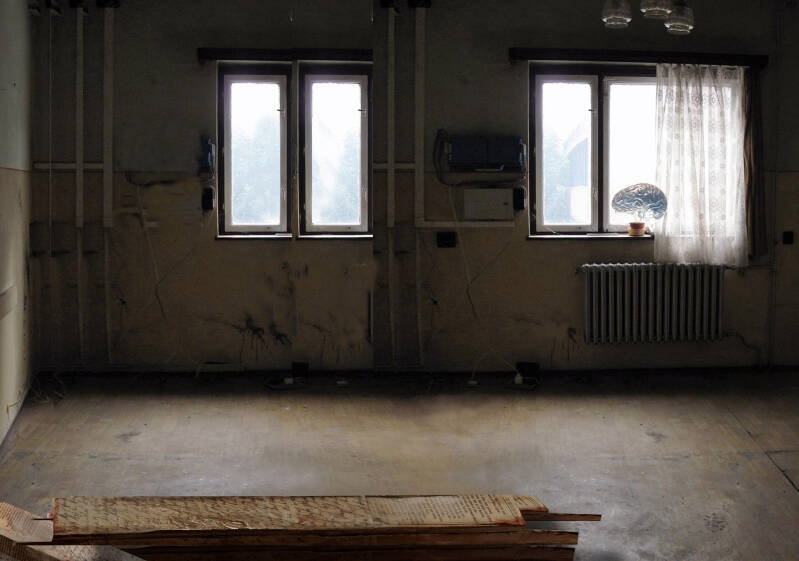transCerebral
Let’s first talk about your aberration, the worst possible kind in the realm of science: your deification of the brain. The brain and not the Code - you idolize the servant and not the master; the creature and not its creator - a ridiculous mistake that only perfect ignorants can make..
(Stanislav Lem: The Golem’s Inaugural Lecture in «Imaginary Magnitude» 1973)
FROM THE BRAINSCAPES SERIES: «transCEREBRAL»
The brainscapes series, started in 2005 and by now grown quite out of hand (or should I say: out of head…?) should be perceived as a pictorial voyage around the human brain. Lâmina 1 (Imaginäre Grösse) was the first picture and as such the matrix of the brainscapes cycle, which later splitted in the abstract Krypta series and the figurative, symbolic transCerebral work.
transCerebral is a critical and satirical reflexion on the ambiguous role of the brain in our society. Far from being the simple instrument of rationality it is supposed to be, our brain often acts as undercover agent at the service of our most sordid instincts, sneakily substituting rationality by what in psychoanalysis is called «rationalisation»: i.e. the invention of pseudo-rational justifications for perfectly irrational behaviour.
The cycle turns around two main socio-neurological subjects: primo the extent of genetic and educational patterning of our brain and the consequential question about the degree of free thought and decision-making (if any) accorded to the human race. In this context, «The Illustrated Man», named in homage to visionary authors from Lem to Bradbury to Amery to Lessing, might be seen as a metaphor of the robot sapiens, «programmed to believe that man is born free», that looks at us from out of the mirror. As the progress of neurobiological science in the last ten years has dramatically shattered our well-meaning illusions about rationality, and the developpement of nanotechnology will soon allow the merging of biological and artificial intelligence, the discussion about the role of predetermination in human decision-making will become one of the most urgent topics of our century.
The second issue is the lob-sided development of our (very advanced) technical intelligence on the one side and our (very retarded) ethical intelligence on the other. «Myopic Mastermind», a kind of dr. Frankenstein of the atomic age, is the artistic incarnation of this unbalanced mindset: an autistic superman whose brain is crammed with cognitive knowledge, but whose social demeanour has hardly evolved since the times of the chimpanzee. For thousands of years, nature has formed our genetic code, and our brain with it, according to the only law it knows: the survival of the fittest. The disastrous result of its single-edged intervention is an asymmetric human mind with an aggressively overdeveloped technical competence - at the expense of ethics, empathy, community feeling and social intelligence. On the one hand, we are able to fly to Mars, to perform complex medical operations and to construct skyscrapers, bridges and any amount of lethal weapons. On the other hand, we are unable to master even our most basic instincts, to construct a solid and peaceful society, to control nature without destroying our planet and to outgrow our murderous racial and typal prejudices. In fine, we seem to be wholly incapable to consistently put our technical knowledge to intelligent, that is to constructive use.
This disparity might offer one possible explanation to Robin Hanson’s Great Filter hypothesis, which, in answer to the Fermi Paradox about the surprising lack of other high technology civilisations, suggests, as one of several possibilities, that the Great Filter might be a direct consequence of technology itself. Advanced civilizations might eradicate themselves by some technology run amok, by global thermonuclear war, by corroding their natural environment or by unprevisible side-effects of their own technical inventions – like the Goethean Sorcerer’s Apprentice unable to control the ghosts he had himself conjured up.
The only way to effectually prevent the abuse of high technology would be a potent global ethic system we are far from having. This is mainly due to the failure of the so-called humanities to rise to the occasion and establish a sustainable philosophy of applied ethics strong enough to escort and monitor technical progress. On the contrary: with its dogged adherence to confirmed fascists like Heidegger or Nietzsche, and their postmodern waffle about «relativity» trailblazing the way for fake news and «alternative truth», the faculties of philosophy and sociology have lost their moral credibility for centuries to come.
By ignoring our moral priorities (or worse, leaving them in the hands of superstitious fools and their criminal «Gods»), humanity is heading straight for collective suicide. It’s high time that we start having a look at what is happening under our very noses and realize that ethics are not the affaire of religion, sentimentalists, romantics and dreamers, but purely and simply an empirical necessity of human survival.
As long as mankind refuses to realize that, for all our superficial sophistication, our social demeanor is still on chimpanzee level, as long as our standard education does not include ethical behaviour, as long as we are ready to follow «leaders» whose moral incompetency is perfectly known and tacitly accepted - so long humanity won’t need climatic catastrophes or asteroids to destroy our planet. We can do it all by ourselves.

MYOPIC MASTERMIND 2019 digital painting limited edition of 10 ex.
THIN THREAD 2019 digital painting limited edition of 10 ex.

THE THINKING PLANET 2019 digital painting
WAYS TO NOWHERE
The “ways to nowhere” cycle is part of a series of computer drafts, showing imaginary installations in imaginary spaces. They are often created with components of my own paintings and sculpture, wandered from their original context into new places and new meaning. The works are exhibited and sold as New Media prints, signed and numbered, at ten editions each. But they are also intended as project studies for “real time” 3D installations.
APATRIDE 2019 digital painting limited edition of 10 ex.
ZARTES PFLÄNZCHEN 2019 digital painting limited edition of 10 ex.
FUNAMBULE 2019 digital painting limited edition of 10 ex.
IN VITRO 2019 digital painting limited edition of 10 ex.
LA CROIX DU SUD 2019 digital painting limited edition of 10 ex.
DOUBLE BLIND 2021 digital painting limited edition of 10 ex.








